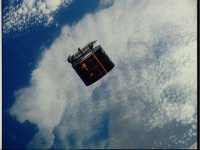Leasat F2
From The Space Library
 | |
| Organization | Department of Defense-Department of the Navy (United States) |
|---|---|
| Mission type | Communications |
| Launch date | November 10, 1984 |
| Launch vehicle | STS-41D |
| Carrier rocket | Space Shuttle |
| Launch site | Cape Canaveral, United States |
| COSPAR ID | 1984-113C |
| Mass | 1315.0 kg |
| Alternate Names | Leased Satellite F1, Syncom IV-2,15236 |
| Additional Information | Here |
| PDMP Information | Here |
| Telecommunications Information | Here |
Leasat F2 was part of a series of five satellites developed as a commercial venture to provide dedicated communications services to the US military. The program was initiated as a result of Congressional reviews in 1976 and 1997 which advised increased use of leased commercial facilities. Owned by Hughes Communications, the satellites were designed to provide global UHF communications to military air, sea, and ground forces. The system's primary user was the US Navy, with some support also provided to the Air Force and ground mobile forces. At the end of each satellite's designed 7 year life, the Navy had the option of purchasing the satellite for $15M. These satellites, along with the Navy's FLTSATCOM spacecraft, were replaced by the UFO (UHF Follow-On) spacecraft. Launched from the Space Shuttle, Leasat was placed in a circular parking orbit at approximately 180 miles (296 km) altitude with 28.6 degrees inclination. The satellites were spin-stabilized, with the spun portion containing the solar array and sun and Earth sensors for attitude determination and Earth pointing reference, batteries for eclipse operation, and all propulsion and attitude control hardware. The despun platform contained Earth-pointing reference, batteries for eclipse operation, and all propulsion and attitude control hardward. The despun platform contained Earth-pointing communcation antennas, communications repeaters, and the majority of the telemetry, tracking, and command (TT&C) equipment. Two large helical UHF antennas provided receive and transmit capability in the UHF band (240 to 400 MHz). Telemetry, command, and the Fleet Broadcast uplink and beacon were in the "exclusive" portions of the SHF band (7250 to 7500 MHz, and 7975 and 8025 MHz). Twelve UHF repeaters provided the main communications capability. The principal Navy Fleet Broadcast function included an SHF uplink, and both SHF and UHF downlinks. The additional antennas for this channel were the SHF uplink and downlink earth coverage horns, which supported the uplink and acquisition/timing function, respectively. The UHF downlink for Fleet broadcast was multiplexed onto the UHF transmit helix.
